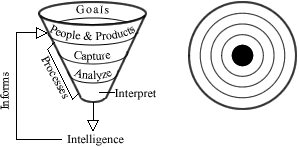Data Flow Framework
An understanding of the available database technologies is important, however, the decision of which database technology to choose cannot be made without a thorough understanding of how well the technology fits within the organizational culture and aligns with its goals. Business leaders learned this lesson the hard way when they failed to clearly define their goals and adequately address the resistance exhibited by members of the culture. At the heart of the resistance are the fears of displacement and inability to adapt. Exacerbating the problem was the added failure to examine and understand current processes and neglecting to adequately train members responsible for those processes. The absence of clear goals complicated matters further by making it impossible to identify what data needed capturing other than what was pre-defined by developers of transactional systems.
Learning from these mistakes, the author conceptualizes the data flow as a cyclical process illustrated by a funnel (Figure 1). At the top of the funnel are the established goals and the people and products that have a direct or indirect influence on achievement of the goals. As a practical matter, organizations may also need to include influential environmental variables, (i.e. political, legal and social), however, for the sake of simplicity, such variables are omitted from the framework. Critical people are those who directly impact goal achievement and those who support goal achievement by overseeing data capturing, analyzing and interpreting processes. Critical products also directly impact goal achievement. Strategic placement of qualified people, well-designed products and well planned processes result in intelligence that informs decision-makers and serves as a catalyst for improvement. When looking inside the funnel from a bird’s eye view, the funnel resembles a target with the bull’s-eye symbolically representing the resulting intelligence that supports decision-making. Conceptualizing the data flow in this fashion emphasizes the importance of goals, people, products and processes when considering database technology solutions and choosing a best fit among competing alternatives. It also provides the basis for answering the questions posed earlier.
When reflecting on the framework, it is important to understand that in real situations, a single organization will have multiple funnels contained within the overarching organization-wide framework. In a corporate setting, this is easiest to visualize departmentally. A sales department naturally has different goals and data capture needs than the human resources department. While departments are typically interdependent, the respective goals actually drive the design of the parts of the system each department uses. Each department may further have nested data flows representing sub-goals and related processes. Reason suggests the deeper the nesting, the greater the granularity of the identified goals and data. This conceptualization allows for the creation of funnels of limited life, such as those representing short-term goals or temporary data processes that help establish performance benchmarks.
For example, a goal may be to determine the feasibility of a new product idea. Data captured from marketing, sales, purchasing, production and shipping can be analyzed and fed into a new product feasibility study funnel, which may be nested within a research and development department funnel. Nesting illustrates how the sub data flow is dependent upon the department data flow, which is further dependent on the organization data flow. By emphasizing sub-goal dependency on overarching goals and sub-goal inheritance of the parent’s data and processes, decision-makers are better equipped to deal with conflicting and incongruent conclusions. Since this systemic approach mandates addressing the key questions for each proposed data flow, it also helps reveal gaps in the data and faulty measures, which for example, in the new product analysis, could lead to an inappropriate go or no go decision.

